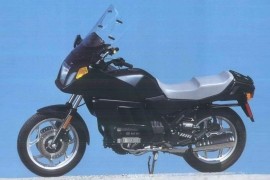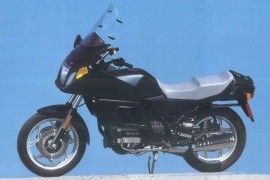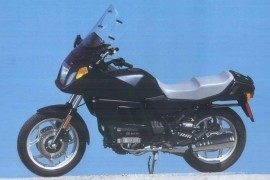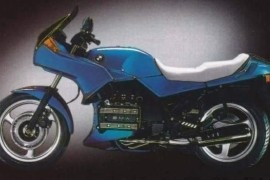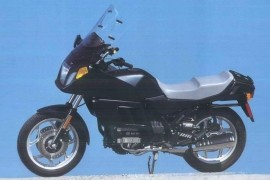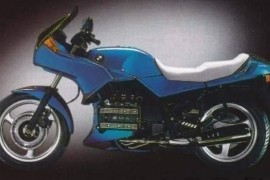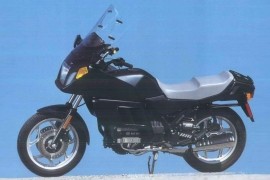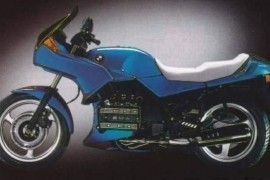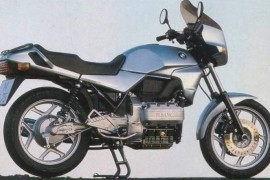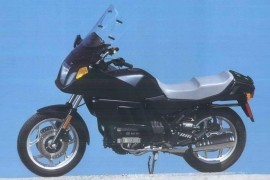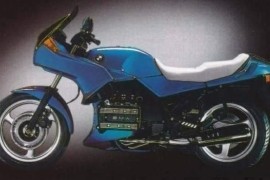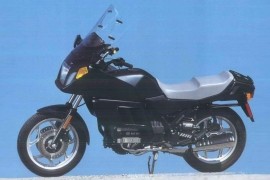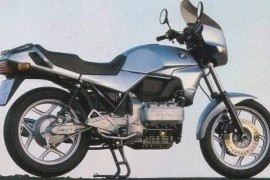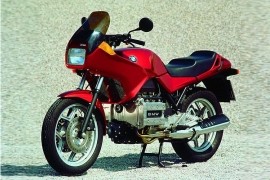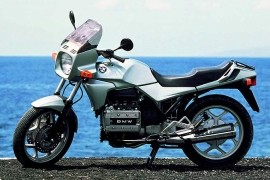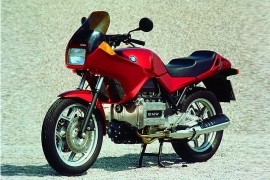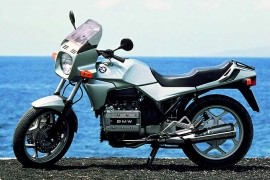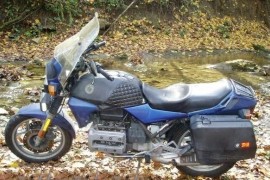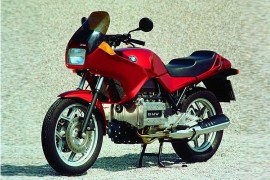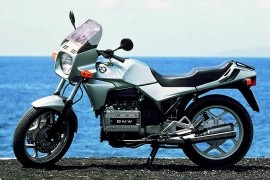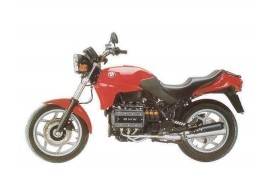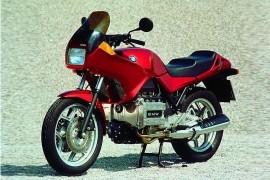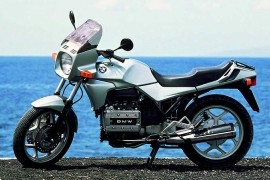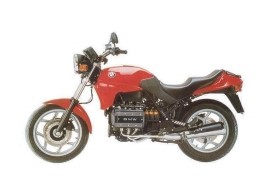BMW K 75 Models/Series Timeline, Specifications & Photos
First production year: 1984
The BMW K75 was a standard naked machine produced by BMW from 1985 to 1995. It was developed alongside the K100 model but released a year later as a marketing strategy. In addition, the K75 model had the same bore and stroke as the K100, generating a displacement of 740cc.
In 1994, the German motorcycle manufacturer launched the BMW K75 RT, a touring machine with a touring fairing, in its ninth consecutive production year, featuring the same specifications as previous models without any changes.
The motorcycle's visual department was characterized by standard features, such as a full fairing with a square headlight, a tall windscreen, a one-piece dual seat with passenger grab rails, side-mounted saddlebags, a three-into-one exhaust system with a muffler mounted on the left-hand side, and eight-spoke aluminum alloy wheels.
It was built around a steel frame with a telescopic fork handling the front suspension and an aluminum swingarm with a single side-mounted shock absorber controlling the rear suspension.
The braking performance was achieved by three 285 mm brake discs, two on the front and one on the rear. The ones from the front were squeezed by dual-piston calipers, while the rear one was handled by a one-piston caliper.
As for the power figures, the 1994 BMW K75 RT's 740cc four-stroke liquid-cooled three-cylinder engine delivered an output power of 75 hp at 8,500 rpm and 68 Nm (50 lb-ft) torque at 6,750 rpm.
The BMW K75 RT was a more touring-oriented version of the base K75 model. The K75 RT debuted in 1985 and was manufactured until 1995 alongside other versions, like the K75 T (US only), K75 C, and K75 S.
The K75 S and K75 RT versions were the only ones in the family that packed a rear brake disc and 17-inch rear wheels, unlike the other versions that were equipped with a single leading shoe drum unit and 18-inch rear wheels.
In 1993, the German motorcycle manufacturer from the House on Munich released the BMW K75 RT, a touring-oriented machine fitted with full touring fairing. In addition, some taller riders complained about wind blowing into their face, so the maker installed an adjustable windscreen on later models.
In the aesthetic department, the motorcycle had standard fittings, like a full fairing with a square headlight, a tall windscreen, a one-piece dual seat with passenger grab rails, side-mounted saddlebags, a three-into-one exhaust system with a muffler mounted on the left-hand side, and eight-spoke aluminum alloy wheels.
In the performance department, the 1993 BMW K75 RT took its muscles from a 740cc four-stroke liquid-cooled three-cylinder engine controlled by a fuel injection system, boasting 75 hp with a peak force at 8,500 rpm and 68 Nm (50 lb-ft) torque at 6,750 rpm.
The BMW K75 was a standard motorcycle manufactured by BMW from 1985 to 1995. It was developed alongside the K100 model but released a year later as a marketing strategy. In addition, the K75 model had the same bore and stroke as the K100, generating a displacement of 740cc.
It was available in several versions, like the base K75 without fairings, the K75 T made only for the US market with touring saddlebags, engine crash bars, a rear top case, and a windscreen, the K75 C with a small cockpit mounted on the handlebar, the K75 S with a sports fairing, stiffer suspensions, and a lower, narrower handlebar, and the K75 T with a full touring fairing.
In 1992, the German motorcycle maker released the BMW K75 RT, a touring machine with a touring fairing, in its eighth consecutive production year. The 1992 model packed the same specifications as previous models without any changes.
The 1992 BMW K75 RT was powered by a 740cc four-stroke liquid-cooled three-cylinder engine mounted underneath the fuel tank, delivering 75 hp at 8,500 rpm and 68 Nm (50 lb-ft) torque at 6,750 rpm.
In the braking department, the motorcycle's eight-spoke aluminum alloy wheels were fitted with three 285 mm brake discs, two on the front and one on the rear. The ones from the front were engaged by dual-piston calipers, while the rear one was handled by a one-piston caliper.
The BMW K75 was a standard motorcycle manufactured by BMW Motorrad from 1985 to 1995. The K75 was developed alongside the K100 model but released a year after the K100 as a marketing strategy.
The standard model was the base for several versions, like the K75 T, which was only for the US market and packed a windscreen, touring panniers, engine crash bars, and a top case, the K75 C with a small cockpit fairing mounted on the handlebar, the K75 S with a sports fairing, stiffer suspensions, and a lower and narrower handlebar, and the K75 T with a full touring fairing.
In 1991, the German motorcycle manufacturer launched the BMW K75 S, a motorcycle in its seventh consecutive production year that packed the same specifications as the previous model without any changes.
The bike was built around a steel frame with a telescopic fork on the front that provided 185 mm wheel travel and a left-hand side-mounted shock absorber with 114 mm of travel paired with an aluminum swingarm.
As for the power figures, the 1991 BMW K75 S was set in motion by a 740cc four-stroke liquid-cooled three-cylinder engine with a fuel injection system in charge, boasting 75 hp at 8,500 rpm and 68 Nm (50 lb-ft) torque at 6,750 rpm.
In 1991, the German bike maker released the BMW K75 RT, a more touring-oriented version of the base K75 model with a touring fairing and a large windscreen. Over its production period, the maker produced over 21,200 units.
The 1991 motorcycle came in the same shape and form as the previous model, packing the same technical, visual, and performance specifications without any significant modifications whatsoever.
The motorcycle's visual department was characterized by standard features, such as a full touring fairing with a rectangular headlight, a large touring windscreen, a one-piece dual seat with pillion grab handles, eight-spoke aluminum alloy wheels, and a three-into-one exhaust system with a silencer mounted on the left-hand side.
The bike was built around a steel frame that housed a telescopic fork with 185 mm of travel on the front end, guiding the front wheel equipped with two 285 mm brake discs and dual-piston calipers. The rear wheel was handled by a side-mounted shock absorber with 114 mm of travel, an aluminum swingarm, and a 285 mm brake disc with a single-piston caliper.
As for the power figures, the bike delivered 75 hp with a peak force at 8,500 rpm and 68 Nm (50 lb-ft) torque at 6,750 rpm, coming from a 740cc four-stroke liquid-cooled three-cylinder engine managed by an Electronic Fuel Injection (EFI) system.
The BMW K75 S was a naked motorcycle manufactured by the German Company in 1985. It was derived from the standard K75 model, featuring the same specifications but fitted with a sports fairing and a rectangular headlight.
In 1990, the German bike maker released the BMW K75 S, a more sporty version of the base model. It was in its sixth consecutive production year and came with the same specifications as the previous model without any changes.
The bike boasted standard features in the visual department, including three-spoke lightweight aluminum alloy wheels, a three-into-one exhaust system, a two-up seat with passenger grab handles, a sports fairing with a square headlight, and a medium-sized windscreen.
It packed the same suspension system as other K75 models, comprised of a telescopic fork on the front that provided 185 mm of travel and an aluminum swingarm with a right-hand side-mounted shock absorber with 114 mm of travel.
In terms of power, the 1990 BMW K75 S had its soul brought to life by a 740cc four-stroke liquid-cooled three-cylinder engine mounted underneath its fuel tank, delivering an output power of 75 hp at 8,500 rpm and 68 Nm (50 lb-ft) torque at 6,570 rpm.
All the power generated by the engine was transmitted to a five-speed gearbox controlled by a dry single-plate clutch. The motorcycle reached a top speed of 210 kph (131 mph) via a final shaft drive linked to the transmission.
In 1990, the German motorcycle maker released the BMW K75 RT, a long journey-oriented motorcycle that could also handle the urban jungle. Compared to the standard BMW k75, the RT version packed a full touring fairing with a large windscreen.
The 1990 machine came equipped with the same standard features, accessories, technical, visual, and performance specifications as the previous model without any significant changes whatsoever.
The motorcycle's visual department was characterized by standard fittings, like a full touring fairing with a rectangular headlight, a large touring windscreen, a one-piece dual seat with pillion grab handles, eight-spoke aluminum alloy wheels, and a three-into-one exhaust system with a silencer mounted on the left-hand side.
In addition, the K75 RT and K75 S were the only models in the range that packed a rear braking disc and 17-inch rear wheels, unlike the other models that featured a single leading shoe drum unit and 18-inch rear wheels.
The bike was built around a steel frame that housed a telescopic fork with 185 mm of travel on the front, guiding the front wheel fitted with two 285 mm discs and dual-piston calipers. The rear wheel was assisted by a side-mounted shock absorber with 114 mm of travel and a single 285 mm disc with a single-piston caliper.
The 1989 BMW K75 RT was powered by a 740cc four-stroke liquid-cooled three-cylinder engine that delivered 75 hp with a peak force at 8,500 rpm and 68 Nm (50 lb-ft) torque at 6,750 rpm.
The 1989 BMW K75 S was released with the same technical, visual, and performance specifications as the previous model without any significant modifications whatsoever. The K75 S was identical to the base model but packed a sportier fairing and a square headlight.
It packed standard fittings such as three-spoke lightweight aluminum alloy wheels, a three-into-one exhaust system, a two-up seat with passenger grab handles, a sports fairing with a square headlight, and a medium-sized windscreen.
In addition, the bike was addressed to a broad category of riders and handled the role of a daily commuter for the urban jungle. Still, the bike managed weekend runs outside the city, being fitted with appropriate accessories.
Suspension-wise, the motorcycle packed a telescopic fork on the front that provided 185 mm of travel and an aluminum swingarm with a right-hand side-mounted shock absorber with 114 mm of travel.
Unlike other versions of the base K75 model, the S version packed a 285 mm brake disc on the rear squeezed by a single-piston caliper. The front wheel was fitted with two 285 mm discs and dual-piston calipers.
In the power department, the 1989 BMW K75 S took its muscles from a 740cc four-stroke liquid-cooled three-cylinder engine mounted underneath its fuel tank and fed by a fuel injection system, delivering an output power of 75 hp at 8,500 rpm and 68 Nm (50 lb-ft) torque at 6,570 rpm.
The BMW K75 was a naked two-wheeler manufactured by the German company in 1985. It was powered by a three-cylinder engine with a balancer shaft and a final shaft drive.
The bike was produced until 1995 and was available in several variants, like the US-only naked K75 T, the bikini-fired K75 C, the sport-faired K75 S, the naked base model K75, and the fully-faired K75 RT.
In 1989, the German motorcycle manufacturer launched the BMW K75 C, a motorcycle derived from the standard K75 model with an additional small cockpit fairing mounted on the handlebar.
Aesthetically, the motorcycle had standard fittings, like a front cowl with a round headlight, a small windscreen, a bikini fairing, a one-piece double seat with pillion grab rails, a three-into-one exhaust system with a silencer mounted on the left-hand side, a center stand, eight-spoke aluminum alloy wheels, and optional panniers.
It was manufactured around a steel frame with a telescopic fork with 185 mm of travel on the front and an aluminum swingarm with a right-hand side-mounted shock absorber with 114 mm of travel.
As for the power figures, the 1989 BMW K75 C had installed a 740cc four-stroke three-cylinder liquid-cooled engine between the two wheels, boasting 75 hp at 8,500 rpm and 68 Nm (50 lb-ft) torque at 6,750 rpm.
In 1989, the German motorcycle manufacturer launched the BMW K75 RT, a long-journey-oriented motorcycle derived from the standard BMW K75 model. The RT version packed a full touring fairing compared to the base model.
In the visual department, the motorcycle had standard fittings, such as a full touring fairing with a rectangular headlight, a large touring windscreen, a one-piece dual seat with pillion grab handles, eight-spoke aluminum alloy wheels, and a three-into-one exhaust system with a silencer mounted on the left-hand side.
The S and RT versions were the only ones in the range with a rear braking disc and 17-inch rear wheels, unlike the other models that packed a single leading shoe drum unit and 18-inch rear wheels.
In the power department, the 1989 BMW K75 RT had its heartbeat set by a 740cc four-stroke liquid-cooled three-cylinder engine that delivered an output power of 75 hp with a peak force at 8,500 rpm and 68 Nm (50 lb-ft) torque at 6,750 rpm.
Suspension-wise, the bike packed a telescopic fork with a hydraulic shock absorber on the front end and an aluminum swingarm with a right-hand side-mounted shock absorber on the rear.
As for the braking power, the motorcycle's wheels were fitted with two 285 mm brake discs coupled to dual-piston calipers on the front and a 285 mm disc with a single-piston caliper on the rear.
The BMW K75 S was a naked motorcycle manufactured by the German Company in 1985. It was derived from the standard K75 model but fitted with a sports fairing and a rectangular headlight.
In 1988, the German motorcycle maker released the BMW K75 S, a machine built for over four years alongside other models derived from the base model with slight visual and technical differences.
The 1988 S model came in the same shape and form as the previous one, packing the same technical, visual, and performance specifications without any significant changes whatsoever.
The bike packed standard fittings in the aesthetic department, such as three-spoke lightweight aluminum alloy wheels, a three-into-one exhaust system, a two-up seat with passenger grab handles, a sports fairing with a square headlight, and a medium-sized windscreen.
The 1988 BMW K75 S had heartbeat set by a 740cc four-stroke liquid-cooled three-cylinder engine mounted underneath its fuel tank, delivering an output power of 75 hp at 8,500 rpm and 68 Nm (50 lb-ft) torque at 6,570 rpm.
The power generated by the engine was transmitted to a five-speed transmission with a manual dry single-plate clutch that sent it to the rear end via a final shaft drive, pushing the machine to a top speed of 210 kph (131 mph).
In 1989, BMW launched the K 75 RT, another version of the three-cylinder series with the main focus on loyal government customers, primarily police forces that used the R 80 RT boxer model in patrol duty and was ready to be replaced by a modern successor.
With this focus in mind, the BMW K 75 model was upgraded with the K 100 RT fairing and resulted in a handy K 75 RT gratefully received by the police departments. Also, for customers that didn’t care too much about the horsepower and the 1000s prestige, the model was a serious alternative to the K 100 RT/LT.
In 1996, the K 75 RT Ultima was a special model in a Cobalt Blue special paint finish with extended standard equipment, and just like its name says, it marked the end of the K 75 series.
The three-cylinder in-line engine that powered the 1989 BMW K 75 RT with a power output of 75 hp with a peak at 8,500 rpm and 68 Nm (50 lb-ft) of torque available at 6,750 rpm and the help of a five-speed manual transmission made possible for the bike to reach at a top speed of 185 kph (115 mph).
Standard features that came with the bike included a large windscreen, a half-fairing, a dual seat, an analog instrument cluster, a rear luggage rack, cast-aluminum wheels, and a center stand.
The BMW K75 was a naked two-wheeler introduced by the German company in 1985. It was powered by a three-cylinder engine with a balancer shaft and a final shaft drive. The bike was produced until 1995 and was available in several variants, like the US-only naked K75 T, the bikini-fired K75 C, the sport-faired K75 S, the naked base model K75, and the fully-faired K75 RT.
In 1988, the German motorcycle maker released the BMW K75 C, a motorcycle derived from the base model that featured a bikini fairing. In other departments, the C version was identical to the standard machine.
As for the standard fittings, the bike packed a front cowl with a round headlight, a small windscreen, a bikini fairing, a one-piece double seat with pillion grab rails, a three-into-one exhaust system with a silencer mounted on the left-hand side, a center stand, eight-spoke aluminum alloy wheels, and optional panniers.
The bike was produced around a steel frame that housed the suspension system, which comprised a telescopic fork with 185 mm of travel on the front and an aluminum swingarm with a right-hand side-mounted shock absorber with 114 mm of travel.
Performance-wise, the 1988 BMW K75 C had installed a 740cc four-stroke three-cylinder liquid-cooled engine at its core, delivering an output power of 75 hp at 8,500 rpm and 68 Nm (50 lb-ft) torque at 6,750 rpm.
In 1987, the German motorcycle manufacturer launched the BMW K75 S, basically a base K75 model fitted with a sporty fairing. It was in its third consecutive production year and came with the same package as the previous model.
The BMW K75 was a naked motorcycle introduced by the German motorcycle maker in 1985. It was powered by a three-cylinder engine with a balancer shaft and a final shaft drive.
The base model was manufactured until 1995 and was marketed in several variants, like the US-only naked K75 T, the bikini-fired K75 C, the sport-faired K75 S, the naked base model K75, and the fully-faired K75 RT.
The 1987 K75 S model came in the same shape and form as the previous one, packing the same technical, performance, and visual specifications without any significant modifications.
In the aesthetic department, the motorcycle was fitted with standard features, like a sports fairing with a square headlight, a medium-sized windscreen, a two-up seat with passenger grab rails, a single muffler mounted on the left-hand side, and eight-spoke aluminum alloy wheels.
The 1987 BMW K75 S had its soul brought to life by a 740cc four-stroke liquid-cooled three-cylinder engine mounted underneath its fuel tank, boasting 75 hp at 8,500 rpm and 68 Nm (50 lb-ft) torque at 6,570 rpm.
In 1987, the German motorcycle maker released the BMW K75 C, one of the many versions of the base K75 model. It was in its third consecutive production year and was virtually unchanged.
It came with the same package as previous models, delivering the same visual, performance, and technical specifications without any significant modifications whatsoever.
Aesthetically, the motorcycle had standard fittings, like a nose fairing with a round headlight, a small windscreen, a radiator fairing, a one-piece dual seat with pillion grab rails, a three-into-one exhausts system with a single silencer mounted on the left-hand side, eight-spoke aluminum alloy wheels, and optional panniers.
It was built around a steel frame and was softened by a telescopic fork with 185 mm of travel on the front and an aluminum swingarm with a single shock absorber mounted on the right-hand side that offered 114 mm wheel travel.
The 1987 BMW K75 C had installed a 40cc four-stroke liquid-cooled three-cylinder engine underneath its fuel tank, delivering an output power of 75 hp at 8,500 rpm and 68 Nm (50 lb-ft) torque at 6,570 rpm.
A five-speed manual transmission with a dry single-plate clutch redirected the power generated by the engine to the rear axle via a final shaft drive, pushing the machine to a top speed of 196 kph (122 mph).
The BMW K75 was a naked motorcycle introduced by the German motorcycle maker in 1985. It was powered by a three-cylinder engine with a balancer shaft and a final shaft drive.
The bike was produced until 1995 and was available in several variants, like the US-only naked K75 T, the bikini-fired K75 C, the sport-faired K75 S, the naked base model K75, and the fully-faired K75 RT.
In 1986, alongside the base model, the German manufacturer released the BMW K75 S, a different version of the base model fitted with a sports fairing. It was in its second production year, and besides the fairing, it was identical to the standard version.
Aesthetically, the bike had standard fittings, such as a sports fairing with a square headlight, a medium-sized windscreen, a two-up seat with passenger grab rails, a single muffler mounted on the left-hand side, and eight-spoke aluminum alloy wheels.
As for performance, the 1986 BMW K75 S took its muscles from a 740cc four-stroke liquid-cooled three-cylinder engine mounted underneath its fuel tank, boasting 75 hp at 8,500 rpm and 68 Nm (50 lb-ft) torque at 6,570 rpm.
The engine's power was transmitted to a five-speed manual transmission with a dry single-plate clutch, linked to the rear wheel through a final shaft drive, launching the motorcycle to a top speed of 196 kph (122 mph).
In 1986, the German motorcycle manufacturer released the BMW K75 C, a motorcycle in its second production year. Compared to the base model, the C version packed a bikini fairing, a nose fairing, and optional side-mounted panniers.
The 1986 machine was delivered with the same package as the previous model, featuring the same technical, visual, and performance specifications without any significant modifications whatsoever.
As for the visual department, the motorcycle had standard fittings, such as a nose fairing with a round headlight, a small windscreen, a radiator fairing, a one-piece dual seat with pillion grab rails, a three-into-one exhausts system with a single silencer mounted on the left-hand side, and eight-spoke aluminum alloy wheels.
The 1986 BMW K75 C took its power from a 740cc four-stroke liquid-cooled three-cylinder engine with a fuel injection system feeding the pistons, delivering an output power of 75 hp at 8,500 rpm and 68 Nm (50 lb-ft) torque at 6,570 rpm.
The energy generated by the 740cc engine was redirected to a five-speed transmission, which sent it to the rear wheel via a final shaft drive. The 1986 K75 C model reached a top speed of 196 kph (122 mph).
As for the braking power, the bike's wheels were fitted with three 285 mm discs, two on the front and one on the rear. In addition, the BMW K75 C was made in over 9,000 units over its production period.
The BMW K75 was a naked bike manufactured by BMW starting in 1985. The motorcycle was powered by a three-cylinder engine with a balancer shaft and a final shaft drive. The motorcycle was produced until 1995 and was available in several versions, like the US-only naked K75 T, the bikini-fired K75 C, the sport-faired K75 S, the naked base model K75, and the fully-faired K75 RT.
In 1985, the German motorcycle maker released the BMW K75 T, a naked motorcycle made only for the United States riders. Compared to the base model, the K75 T featured additional hard, lockable panniers, a two-up touring seat, and a large windscreen for better protection.
In any other departments, the T version was identical to the standard model, packing the same technical and performance specifications without any modifications whatsoever.
The bike was produced around a steel frame that housed the suspension system, comprised of a telescopic fork on the front with 185 mm wheel travel, a right-hand side-mounted shock absorber with 114 mm of travel, and an aluminum swingarm.
In the performance department, the 1985 BMW K75 T took its muscles from a 740cc four-stroke liquid-cooled three-cylinder engine managed by an Electronic Fuel Injection (EFI) system, boasting 75 hp at 8,500 rpm and 68 Nm (50 lb-ft) torque at 6,750 rpm.
In 1985, alongside the standard K75 model, the German motorcycle maker introduced the BMW K75 S, a sportier version of the RT model. Compared to the base K75 model, the S version packed a sportier fairing and delivered the same technical, visual, and performance specifications.
The BMW K75 debuted in 1985 and was powered by a three-cylinder engine with a balancer shaft and a final shaft drive. The motorcycle was manufactured until 1995 and was available in several variants, like the US-only naked K75 T, the bikini-fired K75 C, the sport-faired K75 S, the naked base model K75, and the fully-faired K75 RT.
Aesthetically, the motorcycle had standard features, such as eight-spoke aluminum alloy wheels, a center stand, a one-piece dual seat with pillion grab rails, a three-into-one exhaust system with a muffler mounted on the left-hand side, a sports fairing with a rectangular headlight, and a windscreen.
In the performance department, the 1985 BMW K75 S had its soul brought to life by a 740cc four-stroke liquid-cooled three-cylinder engine with a fuel injection system handling the pistons, boasting 75 hp at 8,500 rpm and 68 Nm (50 lb-ft) torque at 6,570 rpm.
The bike's engine was coupled to a five-speed manual transmission with a dry single-plate clutch, linked to the rear wheel through a final shaft drive, pushing the machine to a top speed of 210 kph (131 mph).
The BMW K75 was a naked motorcycle introduced by BMW in 1985, powered by a three-cylinder engine with a balancer shaft and a final shaft drive. The bike was produced until 1995 and was available in several variants, like the US-only naked K75 T, the bikini-fired K75 C, the sport-faired K75 S, the naked base model K75, and the fully-faired K75 RT.
In 1985, alongside the standard model, the German motorcycle manufacturer launched the BMW K 75C, a similar version of the base model with a bikini fairing. The bike was identical to the standard BMW K75 model in other departments.
In the visual department, the motorcycle packed standard fittings, such as a front cowl with a round headlight, a small windscreen, a bikini fairing, a one-piece double seat with pillion grab rails, a three-into-one exhaust system with a silencer mounted on the left-hand side, a center stand, eight-spoke aluminum alloy wheels, and optional panniers.
The bike was built around a steel frame that housed the suspension system, which comprised a telescopic fork on the front with 185 mm of travel and an aluminum swingarm with a single shock absorber mounted on the right-hand side.
As for the power figures, the 1985 BMW K75 C had installed a 740cc four-stroke liquid-cooled three-cylinder engine underneath its fuel tank, boasting 75 hp with maximum strength at 8,500 rpm and 68 Nm (50 lb-ft) torque at 6,750 rpm.
In addition, over its production period, the BMW K75 C was made in over 9,000 units.
In 1985, the K 75 model was introduced, which should have marked the start together with the k 75 S model. BMW decided and gave priority to the K 75 C model, the one with the cockpit fairing fixed to the handlebar, and postponed the production of the basic model for one year.
In 1986, BMW finally released the K 75 basic model that featured a redesigned front end with free-standing turn signals, a round headlight, and an instrument panel. The basic model, with its three-cylinder engine that didn’t look so powerful, and its naked-bike profile, proved to be the most successful K model, with great agile performance.
In addition, thanks to the even lower curb weight of 227 kg (500 lbs), the bike was easily driveable without compromising on straight-line stability.
The 740cc three-cylinder engine that drove the bike out through the gates of the production line came prepared with an output power of 75 hp at 8,500 rpm and 68 Nm (50 lb-ft) of torque available at 6,750 rpm and launched the bike to a top speed of 200 kph (125 mph).
The 1986 BMW K 75 model came with standard features such as a telescopic front fork with a hydraulic shock absorber, a Monolever rear suspension, a dual seat, an analog instrument cluster, cast-aluminum wheels, a rear luggage rack, and a side stand.
In 1985, BMW released the K 75 S, a motorcycle with a sporty style with a half-shell fairing fixed on the frame. The S model featured integrated turn signals and a rectangular headlight in the fairing and was differentiated from the C model by the narrower and lower handlebar, a tighter-tuned sports suspension, and a disc brake onto the 17-inches rear wheel.
The frame and engine were identical to the sister model, but the S motorcycle had a snappier and more precisely drive on winding roads. The elegant half-shell well received by the customers also provided good wind protection and seat ergonomics.
As for the other models, the BMW Motorrad’s wide range of touring accessories with integral cases, tank bags, and much more were also available for the 1985 BMW K 75 S.
The 740cc three-cylinder in-line engine that powered the 75 S model had an output power of 75 hp at 8,500 rpm and 68 Nm (50 lb-ft) of torque with a peak at 6,750 rpm that managed to drag the bike to a top speed of 210 kph (131 mph).
In addition, the model came with features such as a Brembo braking system with dual front discs, a dual seat, cast-aluminum wheels, black engine accents, an analog instrument cluster, and a center stand.
In 1983, the smaller 750cc three-cylinder K 75 C model, developed largely in parallel with the four-cylinder K 100 and K 100 RS, was also planned for release but the maker decided to wait and see if the four-cylinder motorcycles were going to be accepted.
The patient paid off, and with the knowledge gained from the bigger cc class K motorcycles, BMW released the K 75 C and K 75 S models in 1985. The 75 C model had the cockpit fairing fixed to the handlebars, and the 75 S version had a sporty half-shell fixed to the frame.
The three-cylinder engine fitted on the 75 C model had an independent development with an additional balancer shaft that reduced the vibrations and raised the running smoothness of the engine to the level of the four-cylinder unit that powered the K 100 models.
The 1985 BMW K 75 C model, powered by the 740cc three-cylinder engine with a power output of 75 hp at 8,500 rpm and 68 Nm (50 lb-ft) of torque available at 6,750 rpm, gave the bike a top speed of 200 kph (125 mph).
The middle-class naked machine came with standard features such as cast-aluminum wheels, nose-fairing with a windscreen, a dual seat, passenger grab rails, a rear luggage rack, mid-mounted foot controls, an analog instrument cluster, and a center stand.
The 1985 MY BMW K 75 has, at its heart, a liquid-cooled, four-stroke, 740cc, in-line three cylinder powerhouse paired to a five-speed manual transmission that can produce a claimed 75 horsepower and 68 Nm of torque.
Also, this naked machine comes standard with a telescopic front fork with a hydraulic shock absorber, a Monolever rear suspension, a dual seat, an analogue instrument cluster, cast-aluminium wheels, a rear luggage rack, and a large, round headlight.
